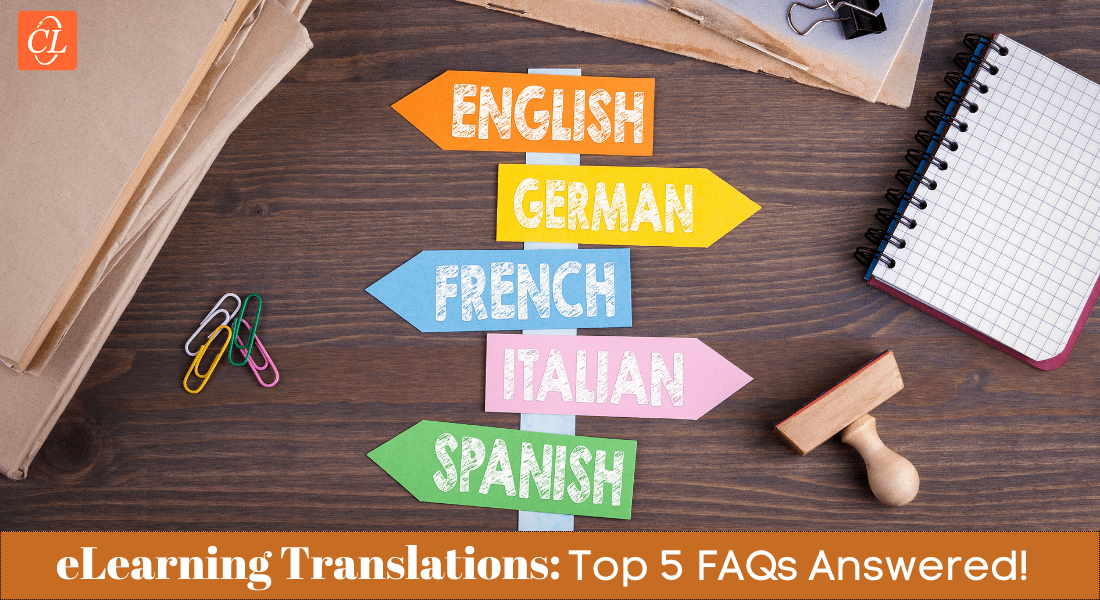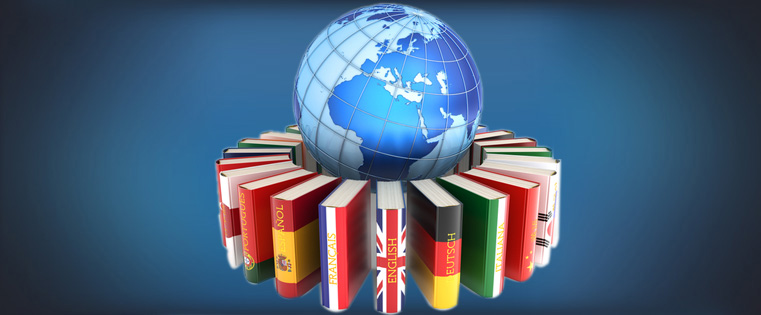Top 5 FAQs About eLearning Translations Answered

ELearning translation is the method of converting an eLearning course from its original language into a particular language or multiple other languages so that the course is accessible to a diverse workforce, across the globe. Translation for eLearning is an efficient way of offering consistent training to your globally dispersed workforce. Hence, by ensuring that your course is accessible to global workforce, you are on the route to success.
There are numerous benefits to using eLearning translations. For example, if the course is available in the learner’s native language, the learner will feel more at ease and will retain the knowledge more effectively. Furthermore, if the master course in English is translated into multiple languages, training consistency is maintained because everyone has access to the same course but in different languages.
Looking Forward to Seamless Translations of Your eLearning Courses?
Here’s a List of Top 5 FAQs That Can Help You Plan Better:- Why is Translation so Important, considering that Most Learners Understand English?
- What does the eLearning Translation Process Involve?
- Is it Possible to Translate eLearning in-House?
- What is TEP, and Why is it Essential for eLearning Translations?
- What are Translation Memory tools?
Let’s look at the most frequently asked questions about eLearning translations and the potential answers to them.
1. Why is Translation so Important, Considering that Most Learners Understand English?
Although English is a global language and most employees understand the basics, not all will have a comprehensive understanding of the meaning of all vocabulary, and when vocabulary is unclear, grasping the concept becomes difficult.
You may believe that Google Translate can be used. But how frequently? Not for every word, correct? Furthermore, due to a lack of revision, Google Translate translates the text roughly and is frequently incorrect. The more complex the text, the more prone it is to errors.
2. What does the eLearning Translation Process Involve?
The eLearning translation process involves two concrete things-
- Translating- the original language of the course into desired languages.
- Developing and publishing- translated text or audio via authoring tools.
Here are 4 crucial steps to follow to roll out high-quality eLearning translations
- Translate the online course’s material- Get the course material translated into the target language by an expert translator.
- Ensure that the translated content has been carefully proofread- Proofread thoroughly to ensure content is error-free.
- Record the audio and get the course developed- Record the audio narratives and develop the translated course.
- Have the stakeholder review the course before delivering it- Obtain stakeholder approval for the course and upload it to the Learning Management System (LMS).
Learn How to Select the Ideal LMS for Hosting eLearning Courses
3. Is it Possible to Translate eLearning in-House?
Yes, it is possible. However, your in-house team should include expert translators with years of experience or specialized training. Just because your full-time employees are fluent in a language does not mean they are qualified to become eLearning translators, as this can lead to the following issues:
Inferior Quality
Because translating is a skill that requires years of training, your employees’ translation abilities may be lacking.
Missed Deadlines
Your employees must also fulfill their primary responsibilities along with translating, resulting in delays and missed deadlines.
Increased Costs
Your employee’s time spent translating your content (away from their actual work) may result in decreased productivity of their actual work.
Absence of Standard Procedure
Your employees may not have established procedures for translating the course.
Lack of Specialized Tools
Your employees may not have the specialized “memory tools” that professional translators use to utilize commonly used phrases and terms.
To avoid all these problems outsourcing is an excellent and smart way. Let’s have a look at a checklist that would come in handy for outsourcing eLearning translations.
How to Make Outsourcing of eLearning Translations Hassle-Free?
i. Prepare in Advance
- Set a budget based on the number of courses that require translation.
- Create a plan for project reviews and deliverables.
ii. Choose a Reliable Vendor
- Look for a skilled vendor who specializes in translation.
- Look for previous experience on similar projects.
iii. Establish an In-House Review Team
- Subject Matter Experts (SMEs) will review the core content.
- Language experts will review the language.
iv. Create a Glossary and Style Guide
- To ensure consistency across translated courses.
- To assist with technical jargon and commonly used words.
v. Request a Prototype
- Examine whether the courses are accurate and user-friendly.
- Before launching the courses, identify and fix any errors.
4. What is TEP, and Why is it Essential for eLearning Translations?
TEP stands for Translation- Editing – Proofreading Process. It is a process which includes three essential steps for a correct, high-quality translation of your eLearning course.
Step 1- Translating the text
Step 2- Editing the text
Step 3- Reviewing the text
In the first step of translation, the text is translated considering language variants and its accuracy according to its country of origin and how the language is in a specific region.
In the second step which is editing, it involves making modifications if necessary and ensuring that the text is correctly aligned with the language.
In the last and final step of TEP process, the text is thoroughly proofread to ensure that there are no errors in grammar, spelling, or punctuation. This is a critical step, and no carelessness is permitted because the process of translation will be finalized after this.
5. What are Translation Memory tools?
Translation Memory (TM) is a database that is used to save translated content for later use. TM is now widely used in the translation and localization industries. It has a feature that saves previously translated text segments and automatically reuses the translated version of the text when it is used again. These tools are both cost effective and time saving because they eliminate the need to translate repetitive texts. This also ensures that the translation is consistent throughout the entire eLearning course.
To Wrap Up!
eLearning translations are an excellent way to provide uniform and consistent training to your global workforce. It is also a gesture to show that you care about them and are taking steps to enhance their learning journey. This simply shows your organization’s cultural competence.
Are you unsure to embark on your eLearning translation journey? Do you have a lot of questions about the subject? Don’t worry, our eBook has answers to some of the most frequently asked questions about eLearning translations. So go ahead and get your free copy now!





